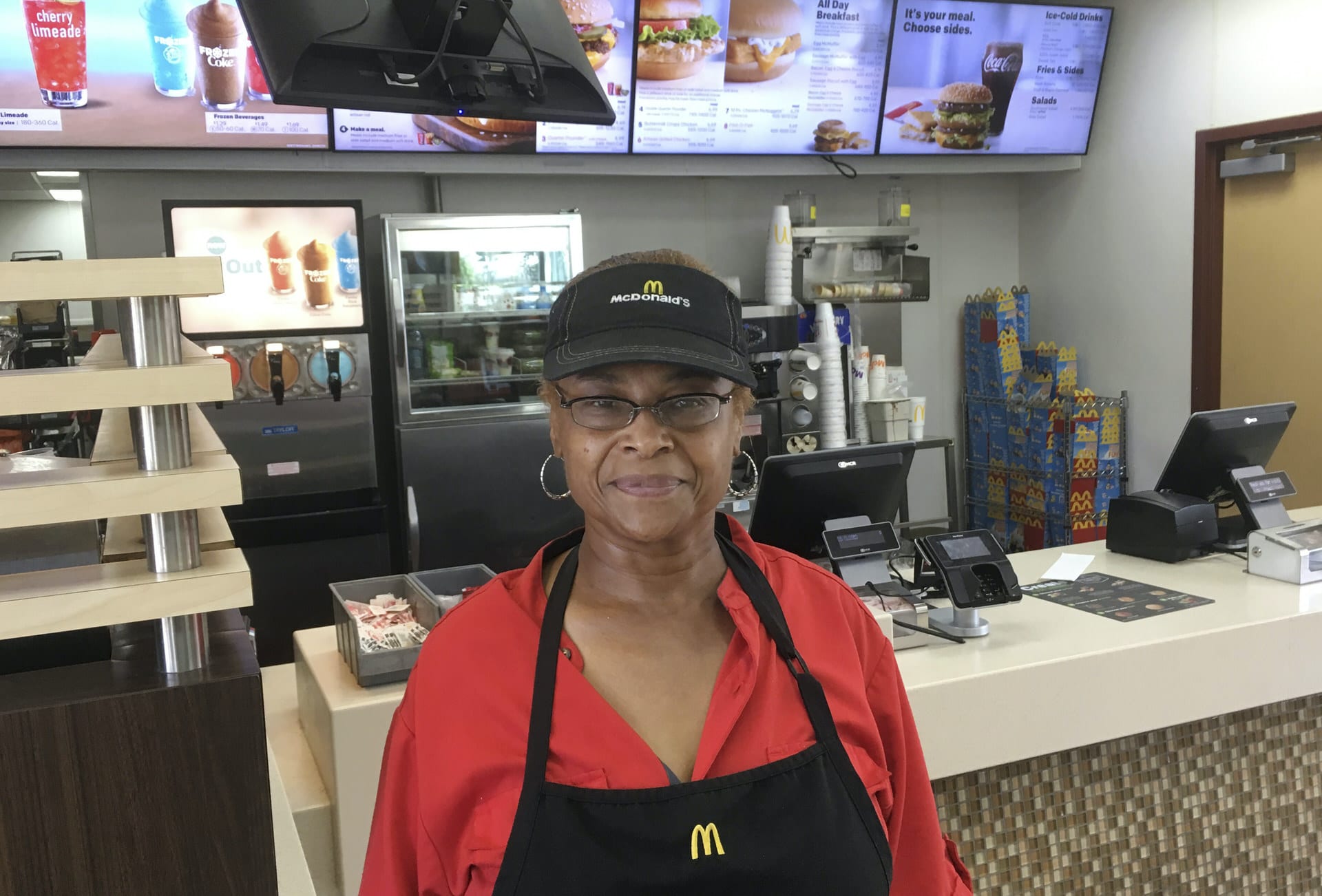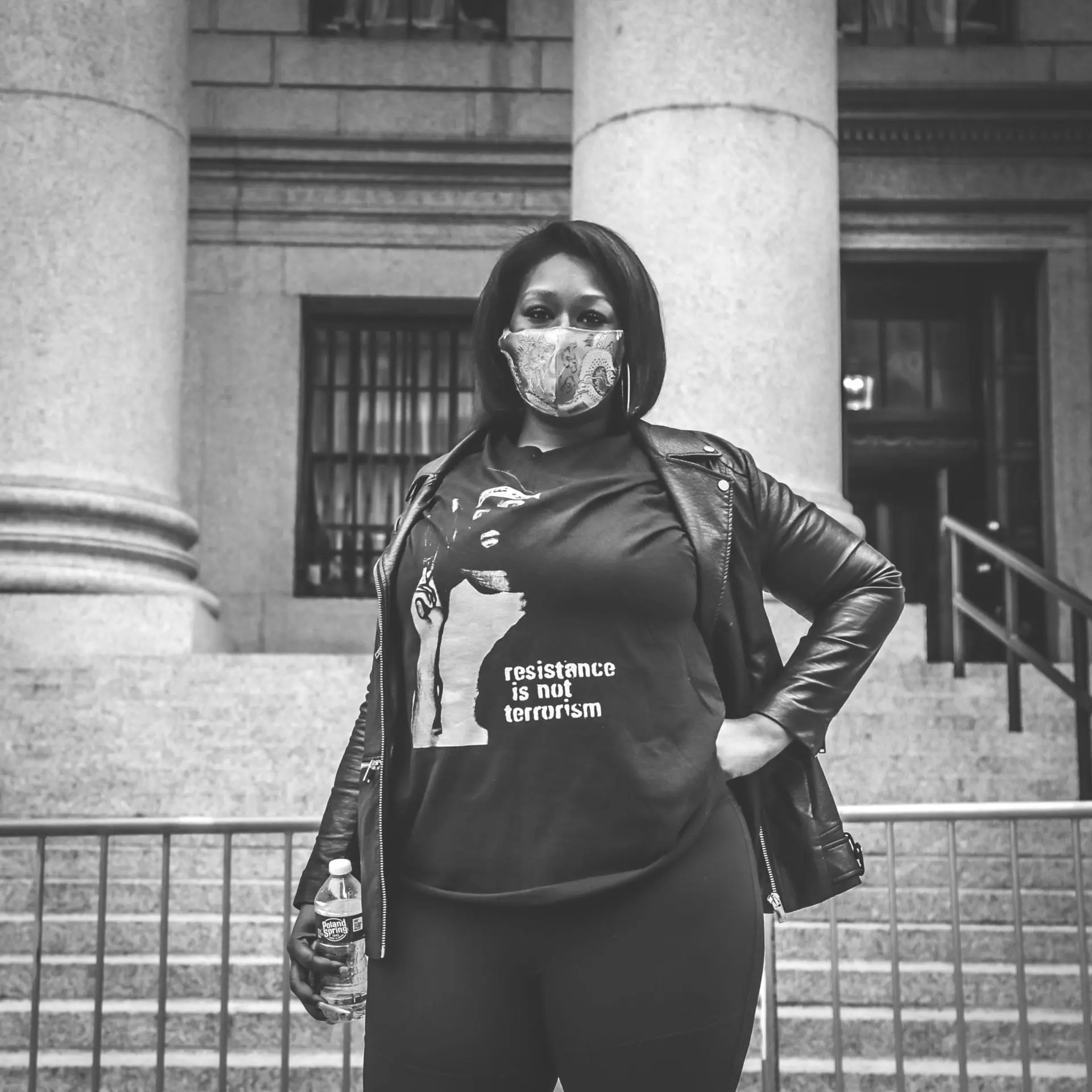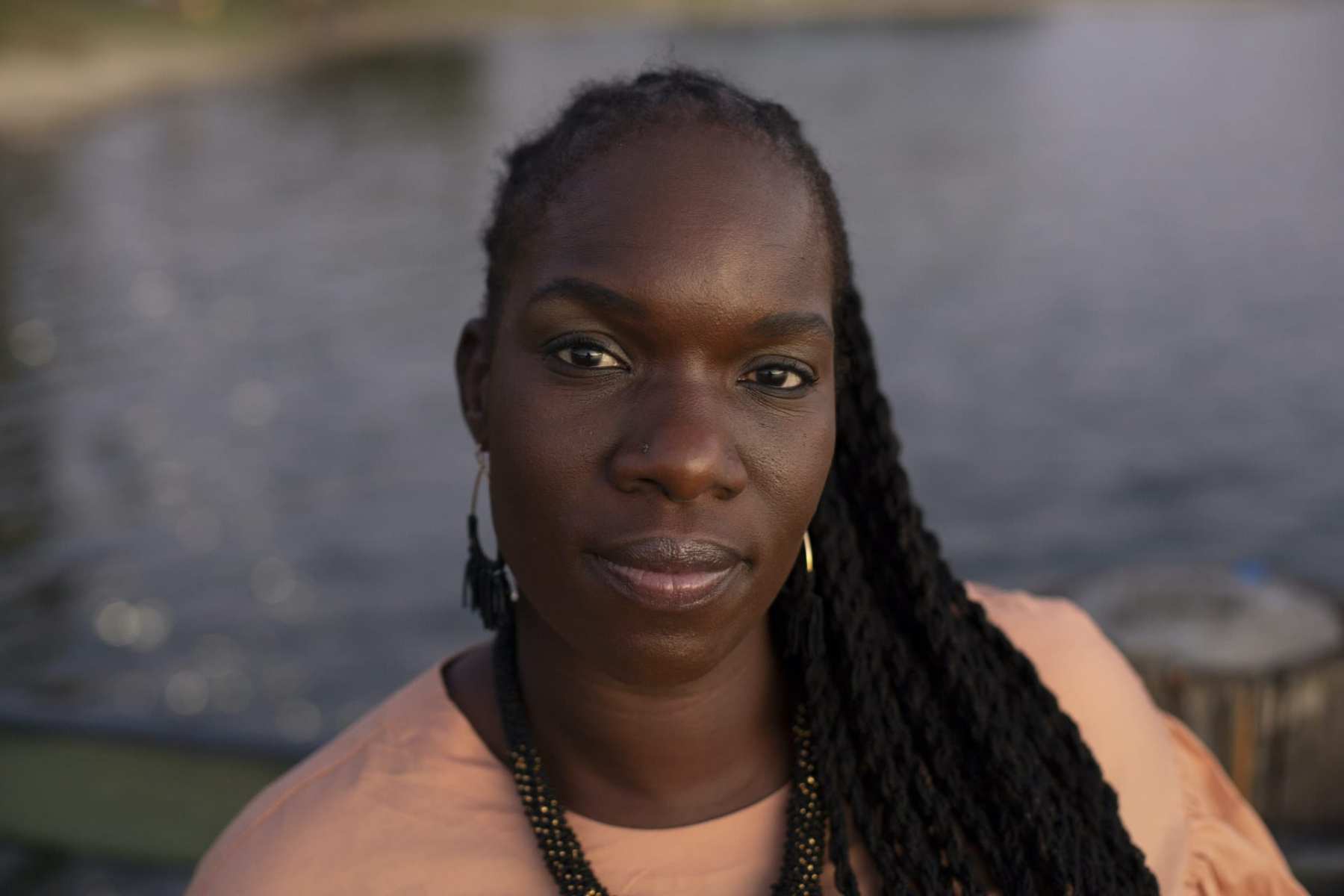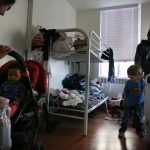The first time Dr. NanaEfua Afoh-Manin stationed her coronavirus testing pop-up site on the edge of a “Black Lives Matter” protest, George Floyd’s face looked down at her from the wall of a boarded up building in West Oakland. The words “can’t be in vain” dripped red from his forehead.
This season of suffering had incensed 43-year-old Afoh-Manin. Black people, sick and alone, filled the Los Angeles hospital where she worked. She set up testing pop-ups across the region, trying to help people before they ended up in her emergency room. Then the death of George Floyd threw the nation into turmoil over a different kind of Black death. So she took her pop-ups from parking lots to protests, enlisting volunteers to swab nostrils and hand out “protest survival kits” packed with goggles and face shields.
Long ago, she had been a protester herself, fighting for affirmative action in California. She had chosen to study medicine after seeing her mother, a respected registered nurse with cervical cancer, treated with apathy by her oncologist. And Afoh-Manin had known fear of the police, the first time as a 15-year-old girl in the back of a patrol car.
Standing among the protesters this summer, she returned to that memory, the one she had repressed. To the stop and the hour-long interrogation. To the handcuffs pushing on her bracelet, cutting into her wrist.
She had cried so hard she fainted. Driving without a license, the officers later said.
Afoh-Manin’s journey, like that of many Black women in America, has been a story of resistance and persistence. But this year brought a new test when two pandemics converged at once.
The original pandemic, racism, has ensured Black women have been at a disadvantage in every conceivable arena — hiring, education, health care, banking — victims of the incomplete crawl toward change. Now, coronavirus-induced economic turmoil has rotted away what little safety net many of these women could rely on.
Black women represent about 11 percent of essential workers even though they’re only 6 percent of the workforce. They’re also one of the only groups for whom unemployment during the pandemic went up from one month to the next, while for others it went down. About 1.4 million jobs held by Black women have vanished since February.
And yet, many are turning this into a moment of action, to seize their economic destiny, to call for respect toward Black lives and, in some cases, to drive the course of progress forward. So that change isn’t gradual or imperceptible, but tangible and real and now.
Afoh-Manin felt that urgency when a Black mother and daughter entered her Los Angeles emergency room in March, coronavirus in their lungs.
The mother went straight to the intensive care unit. The daughter — a single mother herself with two children — avoided the worst of it, but she was asthmatic. Afoh-Manin knew she had to keep her in the hospital, but the young mother didn’t have anyone who could take care of her kids.
The hospital was going to fail this woman, Afoh-Manin realized, because it, too, didn’t have a plan.They’d have to turn to child welfare — a historically punitive system for many Black mothers.
“That’s when I was like, ‘No. Not on my watch.’ I can’t live with myself, and I can’t be part of this,” Afoh-Manin said. “You know something’s happening and there’s a reason why all my lived experiences got me to this point, and it was to get me to get out and say, ‘No, you’re not going to take the kids away from this mom.’”
In the short-term, Afoh-Manin and her team devised a way for the children to stay in the hospital so they wouldn’t go into foster care. The experience inspired her and two fellow Black female doctors to put together $16,000 to create myCovidMD, a nonprofit that provides testing to communities being ravaged by the virus.
But like many Black women-owned businesses, they were denied for the federal government’s coronavirus business stimulus, the Paycheck Protection Program loan. In fact, their first 39 grant applications seeking money earmarked for small businesses, for women-led businesses, for emergency response, were denied.
It was only through Afoh-Manin’s punishing seven-day work weeks, between the hospital and her fundraising schedule, that she was able to put together enough in donations for her program to finally take off, serving more than 3,000 people as of July from Queens to Los Angeles.
To make it happen, she lives by her mom’s mantra: “Mountain, move out of my way.”
Afoh-Manin has thought about the mountains still ahead of her often this year. She’s thought about Breonna Taylor — the 26-year-old EMT was “one of us,” — a health care worker taken not by the virus, but at the hands of police. She’s thought about the faces in the murals.
“I’m gonna resist the knee on my neck,” she said. “No matter what.”
A broken system
For decades, Black women have been fighting to control their fiscal future.
They have historically had the highest labor force participation of any female group — 63 percent at the start of 2020 compared to 58 percent of White women. And they’re avid voters, showing up at consistently higher rates than other groups.
But systems dating back to slavery relegated many of them to work in the agricultural field and as domestic servants in the early 20th century, and racism kept them there long after emancipation. During the New Deal era in the 1930s, southern Democrats in Congress worked to exclude farm workers and domestic service from labor protections like minimum wage, overtime pay and collective bargaining rights.
It wasn’t until the 1970s that Black women started to finally experience some occupational diversity. But they were, and still are, concentrated in low-wage service jobs — the kinds of jobs now labeled “essential” but still lack labor protections such as paid sick leave or even access to health care. Today, Black women are more than twice as likely as White women to work in service occupations.
Despite the challenges, Black women are starting new businesses at the fastest rate of any group. In the past decade, the number of Black women with more than a four-year degree has risen by 37 percent — compared to 23 percent for White women — even though Black women continue to have the highest rate of student loan debt.
That means Black women, who have been part of the labor force at higher rates than other groups and spend more to attain an education, are far less likely to reap the benefits of that work — even when they are in higher-wage positions.
Now, even that marginal progress stands to be eroded as coronavirus threatens women across the socioeconomic spectrum, from business owners to frontline workers.
“When you think about the progress that Black women have made, a lot of times that progress is somewhat precarious. It rests on a set of factors that, if they get pulled out, you realize that the progress that you think has been made is somewhat illusory,” said Jocelyn Frye, a senior fellow at the Center for American Progress, a left-leaning think tank. “When a disruption the magnitude of the pandemic happens, we sort of have to go back to the drawing board and some of the underlying systemic problems rear their head.”
In some instances, the pandemic has pushed Black women out of the labor force altogether, cutting the final tether for women like Anastancia Cuna, a nanny in the Boston area who has lived with little economic protection for years.
When the pandemic hit, she found herself without health insurance — only one in five domestic workers in the nation, who are 92 percent female and 52 percent women of color, are provided health insurance by their employers. Her job was to go into people’s homes when everyone was being advised to socially distance. Cuna feared the physical effects of COVID-19, yes, but more importantly for her, she “could not afford to get sick.”
She quit in March.
Now, with her husband out of work, too, the family has had to cut back on buying meat, poultry and seafood to save money. They buy tofu instead. They don’t have enough to buy their 12-year-old daughter, Nyeleti, a new pair of sneakers.
“It’s hard to have to see the pandemic, which we were not prepared for, and then on top of that the racial injustice that we’re going through,” said Cuna, 38. “It’s just too hard.”
Across the country, Black women are bearing a larger share of that burden as the heads of their households. Nearly 70 percent of Black women are the primary or only breadwinner in their family, according to a report from the Center for American Progress. That’s about twice the rate for White women.
The economy isn’t actually rebounding if Black women are losing more jobs.
Fatima Goss Graves, president and CEO of the National Women’s Law Center
Black households have less in the bank in the case of, say, an economy-tanking global pandemic. In general, they have about five times less in liquid assets — checking and savings accounts, cash and directly held stocks, bonds and mutual funds — than White households: About $8,800 compared to $49,500, according to the Economic Policy Institute.
And Black families are also making less overall. The median household income for a Black household is about $41,700, 70 percent lower than a White household, according to data from the U.S. Census Bureau. That’s due, in part, because it takes Black women until August to catch up to the wages White men made the year before.
Like the Cunas, many Black families also have fewer benefits to rely on. Black workers are 60 percent more likely to be uninsured than White workers.
All of those factors build an insecure bedrock for Black families that is extremely vulnerable to any disruption. The impact shows up in the numbers: In May, for example, Black female unemployment went up to 16.5 percent when it was going down for White women and Latinas. (For Asian women, it also went up month-to-month, from 15.6 percent in April to 16.4 percent in May.)
The reason, said Fatima Goss Graves, president and CEO of the National Women’s Law Center, is systemic racism that has put Black women in the most susceptible jobs. For instance, Black women are the only group whose share of the frontline worker labor force is almost double their share of the overall workforce.
“I worry that people will not be able to understand what’s complicated around that,” Goss Graves said. “There’s a risk that people misunderstand the connection between racial justice and economic justice, and so we want to take on only one and not the other. But the economy isn’t actually rebounding if Black women are losing more jobs.”
Black women are at risk of losing their foothold in the labor force if their role in American households — as primary breadwinners and caretakers, in particular — isn’t addressed.
This includes women like McDonald’s worker Bettie Douglas, the sole income earner in her St. Louis household. Douglas makes $10 an hour and cares for her brother, who is disabled, her oldest son, who is recovering from a brain tumor, and her youngest son, who just graduated high school.
Since the pandemic started, she’s had to fight to keep hours and the full-time status she recently earned after 14 years with the company.

“’I’ve worked from the grill, cashiering, lobby, maintenance — everything,” said Douglas, 62. “I put the burgers together. I’m all over the place. I clean the refrigerator. I’m pulling stuff out of the toilet, I’m a plumber. You name it. I’ve done it there.”
And yet she still can’t scrape together enough to buy a refrigerator. So she rides the bus every day to the grocery store, a task that costs her more in the long run.
For five months this year, she’s watched the bills pile up.
“I haven’t even opened the bills because I’m afraid. I’ve just been collecting them,” she said. “Life shouldn’t be this big of a struggle. I’m just trying to live an honest life.”
And then there’s the relentless racism she said she lives with “on a daily basis.” Douglas said she hopes this is the moment that moves the needle — with the twin pandemics pushing the conversation forward to help address the issues that have long plagued Black women.
“What I can say is that this moment feels different from any other moment I have experienced in my lifetime,” said Nina Banks, associate Professor of Economics at Bucknell University and an expert on Black women in the labor force.
She’s worried some changes will be more symbolic than seismic. But she knows substantive change is coming. She sees it and hears it in the students at her university.
“This is generational,” Banks said. “Younger people get it.”
What comes after protest
The path toward change starts with intent. Intentionality about collecting data on race and ethnicity could help lead to policies that illuminate the barriers to mobility that have long existed for communities of color, said Frye at the Center for American Progress. It wasn’t until The New York Times sued the Centers for Disease Control and Prevention for more data on the racial impact of coronavirus, for example, that the scope of the virus’ assault on people of color came into focus.
It’s not anti-bias training one time, Frye said, but it’s a host of long-term policies that target resources into the areas that breed disparities.
“It’s not easy work, to be sure, but it is very intentional work that is intended to surface disparities that are happening not just to women generally, but to women of color specifically, and to set those as baseline measures,” Frye said. “If you’re not fixing the pay gap for Black women then you’re not fixing the pay gap.”
It’s also addressing the way national crises, like the child care shortage, impact women of color severely. A recent proposal by Senate Democrats, for instance, aims to spend $350 billion over five years to address economic inequalities in communities of color that have been highlighted by coronavirus, including by dedicating funds to stabilizing daycare facilities and giving more families access to child care.
And a recent survey by Lean In found that Black women spend an estimated 12 hours more a week on child care responsibilities than White women. One in five child care providers have lost their jobs since January, weakening a system Black mothers rely on heavily.
“White women in the United States have been socially valued as mothers, but Black women have primarily been viewed as workers without regard to their caregiving needs as mothers,” Banks said.
The Senate proposal is unlikely to get bipartisan support.
In the Bronx, Brigette Brantley has grown up knowing the system wasn’t ever really built to help people like her. When her mom lost her job in the last recession, for example, a worker at the local Human Resources Administration tried to convince her she would be fine with just unemployment insurance, and that she shouldn’t access any other public assistance.
It took Brantley speaking up for her mother for her to get the help she needed.
Now Brantley, 30, is also out of a job after her contract teaching eighth grade social studies wasn’t renewed when the pandemic hit. She’s relying on unemployment insurance for the first time in her life. She already cut the cable, and she’s wondering if she can send her 8-year-old son to school in the fall if she doesn’t even know how she can afford to buy him shoes or do his laundry.

This summer, Brantley has watched the anger bubble in her community, in her students who have nothing to do in a season filled with rage. She’s marched alongside those who are turning their anger into action. Something has changed for her, too.
A clip of her speaking to a reporter during a protest in the Bronx went viral in June because it amplified what so many Black women, and Black mothers in particular, were feeling.
“I’m a Black mother and I’m a social studies teacher and I’m raising a Black son in America so I have no choice but to fight and walk,” Brantley says in the video, answering questions about the protests that at times turned violent. “The government gave $1,200 to people to survive on in March, what you thought was gonna happen? You took summer youth away from the youth, what you thought was gonna happen? They need jobs. Feed our babies and we don’t have this problem.”
At the encouragement of her students, Brantley set up a GoFundMe to launch a tour of five cities, speaking with organizers across the country tackling systemic racism. The fund has collected more than $55,000. But with coronavirus threatening those plans, she’s decided to instead take busloads of children from her community to the Aug. 28 March on Washington — the 57-year anniversary of Martin Luther King Jr.’s “I Have A Dream” speech.
Brantley, who proudly shares that she has the same birthday as activist Angela Davis, believes this is her Angela Davis moment. It’s her chance to see what happens after everything crumbles and a movement is reborn from those ashes.
Does policy change? Does the world?
She needs to see it for herself.
“When the press leaves, does the activism die because it’s not being watched? It shouldn’t be that way, it should always be watched. I was tired of watching it from my TV screen. I want to see it physically,” Brantley said. “I need to physically go see what is the aftermath of what happens.”
From the Collection






